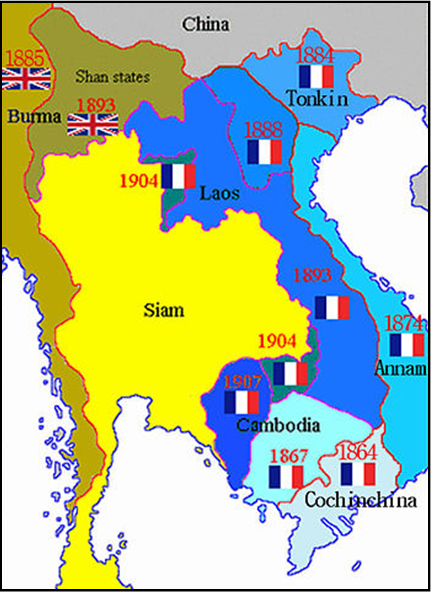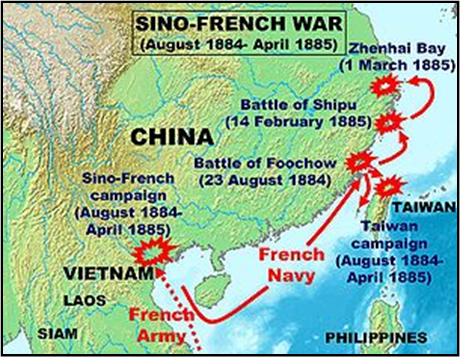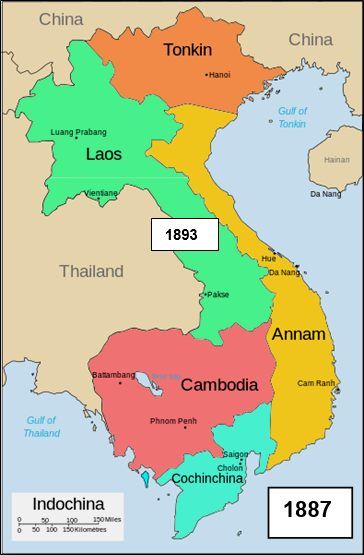


xxxxxThe French
Emperor Napoleon III, under the pretext of protecting the work of
the Paris Foreign Missions Society, invaded Vietnam in 1858. After
capturing the city of Sai Gon in the Mekong Delta, the
expeditionary force went on the offensive in 1862, and quickly
forced the Vietnamese to give way. By 1864 all of the southern
area, known as Cochinchina, was in French hands, together with the
neighbouring kingdom of Cambodia, ceded to the French the previous
year by the Cambodian king as a means of protecting his state
against attacks from his neighbours, Vietnam and Siam (today’s
Thailand). In the early 1880s the French advanced into north
Vietnam, but there they faced stiff opposition from the Black
Flags, members of a gang of Vietnamese and Chinese bandits. They
were defeated on a number of occasions, but in 1883 they
overwhelmed the Vietnamese army at the Battle of Thuan An and
gained control of the northern regions of Assam and Tonkin. The
following year, however, the Chinese opposed this occupation and
the Sino-
FRENCH INDOCHINA 1858 -
Acknowledgements
Map (South-
wiki/File:French+ Indochina. Invasion: published in La
Guerre du Tonkin by the French writer Lucien Huard (1839-
 xxxxxFrenchxinterest in South
East Asia had its beginnings in the 17th century when Father Alexandre de Rhodes,
a French Jesuit, arrived in Vietnam in 1620 to establish a mission. He spent over 15
years there and, on his return to France, was instrumental in
setting up the Paris Foreign Missions Society in 1659. Ostensibly,
it was to protect the work of this
organisation that Napoleon III sent a task force to Tourane
(present day Da Nang) in September 1858, although, as we have
seen, the French Emperor was clearly bent on colonial expansion at
that time.
xxxxxFrenchxinterest in South
East Asia had its beginnings in the 17th century when Father Alexandre de Rhodes,
a French Jesuit, arrived in Vietnam in 1620 to establish a mission. He spent over 15
years there and, on his return to France, was instrumental in
setting up the Paris Foreign Missions Society in 1659. Ostensibly,
it was to protect the work of this
organisation that Napoleon III sent a task force to Tourane
(present day Da Nang) in September 1858, although, as we have
seen, the French Emperor was clearly bent on colonial expansion at
that time.
xxxxxThe force,
made up of 14 gunships and some 5,000 men, occupied the port of
Tourane, but after a few months, plagued by disease, it moved
further south and captured the city of Sai Gon (present day Ho Chi
Minh City) in the Mekong delta. The garrison was then reinforced,
and ordered to go on the offensive in 1862. The Vietnamese were
soon forced to give way. The French obtained treaty ports in Annam
and Tonkin -
xxxxxControl
over Cochinchina, the southern region of Vietnam (see map above),
together with the protectorate over Cambodia, marked the beginning
of French Indochina, but the conquest of northern Vietnam,
regarded by China as their sphere of influence, proved a more
daunting task. In the early 1880s French troops advanced
northwards and took control of Hanoi and Haiphong, but were met
with strong resistance, particularly from the Black Flags, members
of a well-
 xxxxxInxxthe meantime, however,
a powerful naval force had landed near the capital Hué (illustrated), and in August
1883 had overwhelmed the Vietnamese at the Battle
of Thuan An. AxFrench threat to “erase Vietnam from history” forced
them to sue for peace, and by the Treaty
of Hué in June 1884, both Annam and
Tonkin were made French protectorates. Meanwhile, in March 1884
the French had taken on a strong force of Chinese troops, seized
the town of Bac Ninh with comparative ease, and forced them to
come to terms. Byxthe Tientsin
Accord (or Li Fournier Convention),
signed in the May -
xxxxxInxxthe meantime, however,
a powerful naval force had landed near the capital Hué (illustrated), and in August
1883 had overwhelmed the Vietnamese at the Battle
of Thuan An. AxFrench threat to “erase Vietnam from history” forced
them to sue for peace, and by the Treaty
of Hué in June 1884, both Annam and
Tonkin were made French protectorates. Meanwhile, in March 1884
the French had taken on a strong force of Chinese troops, seized
the town of Bac Ninh with comparative ease, and forced them to
come to terms. Byxthe Tientsin
Accord (or Li Fournier Convention),
signed in the May -

xxxxxThe Sino-
xxxxxIn Vietnam,
the major battles occurred in the early months of 1885. A Chinese
force was defeated at the village of Nui Bop in January, and the
Lang Son campaign, launched by the French the following month,
seized the town of Lang Son and, by the Battle of Hoa Moc -
 xxxxxFrench Indochina was
officially established in October 1887, comprising Cochinchina, Annam and Tonkin (modern Vietnam) and the kingdom of Cambodia, but the general conduct of the war -
xxxxxFrench Indochina was
officially established in October 1887, comprising Cochinchina, Annam and Tonkin (modern Vietnam) and the kingdom of Cambodia, but the general conduct of the war -
xxxxxIncidentally, Laos was granted independence in 1949 and Cambodia in 1953. The Southern half of Vietnam became independent in 1949 and, following the defeat of the French at the Battle of Dien Bien Phu, the Viet Minh communist regime of North Vietnam gained its independence in 1954. ……
xxxxx…… As we have seen, the advance of the French in South
East Asia and the interest they showed in forging commercial links
with Burma, alarmed the British. Following a trading dispute with
the Burmese king Thibaw Min, they invaded Upper Burma in 1885 (the Third Anglo-
Vc-
Including:
The Sino-
War 1884-



